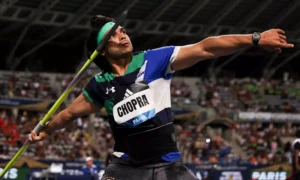GS2 – Polity

Context
The Union Cabinet has approved the National Sports Policy 2025, officially named Khelo Bharat Niti 2025, which revamps India’s sports governance and development framework.
Highlights of NSP 2025
- Global Sporting Excellence:
- Structured talent pathways
- Enhanced sports infrastructure
- Training driven by sports science
- Strengthening of National Sports Federations (NSFs) and leagues
- Economic Development through Sports:
- Boosting sports tourism
- Promoting indigenous manufacturing and startups
- Encouraging CSR and PPP investments in sports
- Sports for Social Transformation:
- Inclusive participation
- Revival of traditional Indian sports
- Linking sports to community development and employment
- Sports as a Mass Movement:
- Nationwide fitness campaigns
- Creation of fitness indices
- Public access to sports facilities
- Alignment with National Education Policy (NEP) 2020:
- Sports integrated into academic curricula
- Training of physical educators
- School-based talent identification systems
Strategic Implementation Framework
- Governance:
Legal and regulatory framework to ensure transparency and accountability. - Private Sector Engagement:
Corporate participation through CSR and PPP frameworks. - Technology Integration:
Use of AI, data analytics, and emerging tech for athlete monitoring and program delivery. - Monitoring Mechanism:
Establishment of a National Monitoring Framework with KPIs and time-bound targets. - State-Level Policy Alignment:
NSP 2025 serves as a model policy for States and Union Territories to draft their own sports policies. - Whole-of-Government Approach:
Integration of sports goals into the broader objectives of multiple ministries and departments.
Evolution of India’s Sports Policy
- Post-Independence Era (1947–1980s):
- Primary national focus was on health, education, and poverty alleviation.
- Notable milestones:
- 1951 Asian Games
- 1954 establishment of the All-India Council of Sports (AICS)
- Budget constraints limited global competitiveness, although success in hockey and legends like Milkha Singh emerged.
- 1982 Asian Games:
- Highlighted the need for structured governance.
- Led to the creation of the Department of Sports under the HRD Ministry.
- Resulted in India’s first National Sports Policy in 1984.
- Post-1991 Liberalisation:
- Economic reforms and media exposure boosted public interest in sports.
- 1997 Draft National Sports Policy was proposed but not implemented, creating a policy vacuum.
- Post-2000 Reforms and Initiatives:
- 2000: Ministry of Youth Affairs and Sports established.
- 2001: National Sports Policy aimed at mass participation and elite performance.
- NSDC 2011: For reforming NSFs—ensuring governance, anti-doping compliance, gender equity.
- TOPS 2014: Target Olympic Podium Scheme for elite athletes.
- Khelo India 2017: Youth talent identification and development.
- Fit India 2019: Emphasised physical fitness as a national agenda.
Recent Developments:
- 2024: Drafts of National Sports Policy and National Sports Governance Bill released.
- India’s Olympic bid for 2036 reignited policy reforms and strategic sports planning.




